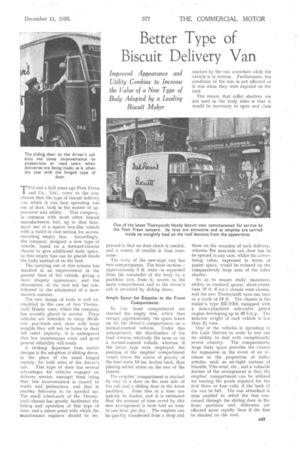Better Type of Biscuit Delivery Van
Page 55

If you've noticed an error in this article please click here to report it so we can fix it.
Improved Appearance and Utility Combine to Increase the Value of a New Type of Body Adopted by a Leading Biscuit Maker
TWO and a half years ago Peek Frean and Co., Ltd., came to the conclusion that the type of biscuit delivery van which it was then operating was out of date, both in the matter of appearance and utility. This company, in common with most other biscuit manufacturers, had, up to that time, made use of a square box-like vehicle with a railed-in roof section for accommodating empty tins. Accordingly, the company designed a new type of vehicle, based on a forward-control chassis to give additional body space, so that empty tins can be placed inside the body instead of on the roof.
The carrying out of this scheme has resulted in an improvement in the general lines of the vehicle, giving a more shapely appearance, and the elimination of the roof rail has contributed to the attainment of a more modern contour.
The new design of body is well exemplified in the case of two Thornycroft Handy vans, which the company has recently placed in service. These vehicles are intended to carry 30-35cwt. -pay-loads and, since with these weights they will not be laden to their full rated capacity, it is anticipated that low maintenance costs and good general reliability will result.
A striking departure from earlier designs is the adoption of sliding doors, in the place of the usual hinged variety, for both sides of the driver's cab. This type of door has several advantages for vehicles engaged on delivery service, amongst them being that less inconvenience is caused to traffic and pedestrians, and that it enables deliveries to be speeded up. The small wheel-arch of the Thornycroft chassis has greatly facilitated the fitting and operation of this type of door, and a minor point with which the maintenance engineer should be im pressed is that no door check is needed, and a source of trouble is thus overcome.
The body of the new-type van has two compartments. The front section— approximately 3 ft. wide—is separated from the remainder of the body by a partition and, from it, access to the main compartment and to the driver's cab is provided by sliding doors.
Ample Space for Empties in the Front Compartment.
In this front compartment are stacked the empty tins, which thus occupy approximately the space taken up by the driver's compartment on a normal-control vehicle. Under this arrangement, the distribution of the load remains relatively the same as on a normal-control vehicle, whereas, if the latter type were employed, the position of the empties' compartment would throw the centre of gravity of the load some 18 ins, farther back, thus placing added stress on the rear of the chassis.
The empties' compartment is reached by way of a door on the near side of the cab and A sliding door in the front partition. Four tins at a time can quickly be loaded, and it is estimated that the amount of time saved by this new arrangement is from half an hour to one hour per day. The empties can be quickly transferredfrom a shop and
stacked by the van attendant while the vehicle is in motion. Furthermore, the condition of the tins is not affected as it was when they were exposed on the roof.
The reason that roller shutters are not used in the body sides is that it would be necessary to open and close them on the occasion of each delivery, whereas the near-side cab door has to be opened in any case, whilst the advertising value, expressed in terms of poster space, would be reduced by the comparatively large area of the roller shutter.
So • as to ensure ready manceuvrability in confined spaces, short-wheelbase (9 ft. 6 ins.) chassis were chosen, and the new Thornycroft vans can turn in a circle of 34 ft. The chassis is the maker's type BE/FB4, equipped with a four-cylindered side-valve petrol engine developing up to 49 b.h.p. The unladen weight of each vehicle is less than 21 tons.
One of the vehicles is operating in the Lake District in order to test out its -ability to deal with exceptionally severe country. The comparatively large body space provides the chance for expansion in the event of an increase in the proportion of bulky articles, such as air-tight cartons of biscuits, Vita-weat, etc., and a valuable feature of the arrangement is that the empties' compartment can be utilized for loading the goods required for the first three or four calls, if the back of the van be full. The van attendant is thus enabled to select the tins concerned through the sliding door in the front partition and deliveries are effected more rapidly than if the tins be stacked on the roof.




































































































